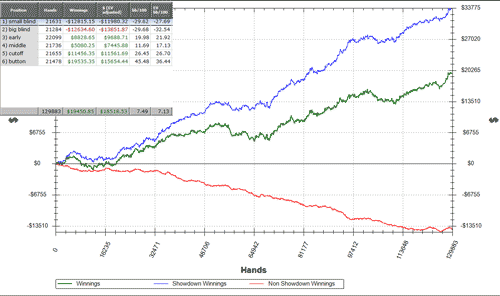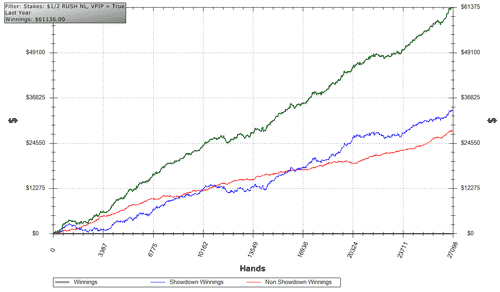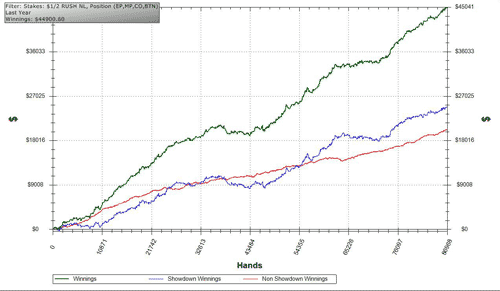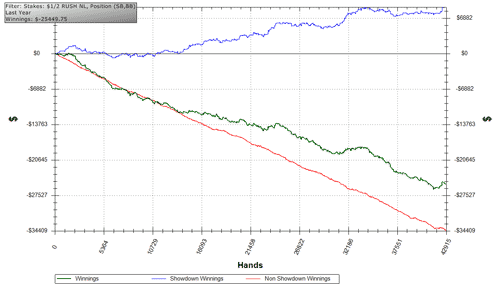The Red Line
Poker Stats: VPIP : PFR : Std Dev : The Red Line

- What is the red line?
- The blinds and the red line
- 5 ways to improve your red line
- Stealing the blinds
- Floating
- Example 1
- Example 2
- Value betting thinner
- Example 1
- Example 2
- Double barreling
- Example 1
- Example 2
- 3barrel bluffing
- Final word on the red line
What is the red line?
The red line you see in Poker Tracker or HoldemManager refers to your non-showdown winnings.
Together with the blue line (your showdown winnings), it makes your green line, which is your total winnings.
A lot of people have negative red lines, and worry about this thinking that it is a problem. It can be a problem if your red line slopes down far too quickly, however for the most part it is going to be very style dependant on whether you have a negative or positive red line. It doesn't automatically make you a good or bad player depending on where your red line falls.
The red line is affected whenever you win or lose a pot without getting to showdown.
- Every time you fold before showdown your red line goes down.
- Every time you bet and make your opponent fold before showdown your red line goes up.
Intuitively this may seem as though to get a positive red line you have to be a complete calling station and monkey bluff every time your opponent checks. However this is not the case.
Want to find out about your own red line? If you don't know how your non-showdown winnings are performing, grab a copy of Poker Tracker and find out.
The blinds and the red line.
The blinds play a huge role in your red line. Take a look at my red line for my sample of Rush Poker in 2010 (graph 1).

As you can see despite winning overall at quite a healthy rate, I lose a lot of money at non-showdown. It may seem as though I don't bluff enough or call down light often enough, but lets look at the other graphs of my play.
We can see that when I voluntarily put money in the pot (VPIP = true), I am winning a lot of money through non showdown winnings (graph 2).

We can also see when I am in the positions from under the gun around to the button I make a lot of money without showdown too (graph 3).

So where do I lose it? If we look at my play from the blinds we can see that my red line there is atrocious! (graph 4)

Quite simply this is because I am being forced to put money in every single time I am in the blinds without a choice. Furthermore, I have to play tight from the blinds because I will be out of position for the entire hand, which means I end up folding a lot of hands preflop there and giving up my blinds, hence making my red line go down rapidly.
So when you factor in my blind play, its quite obvious that I am doing okay really with regards to my red line and its not something I should be concerned with too much.
However a drastically negative red line can be caused by a few things and fixing it is relatively easy. Here I explain how:
5 ways to improve your red line.
1) Stealing the blinds.
Every time you successfully steal the blinds you add something to your red line. Additionally, every time the blinds call but check/fold to your continuation bet you increase your red line, which is great.
2) Floating.
When we call a raise preflop, we shouldn't be folding to many cbets. If you play really fit or fold then you are going to lose a ton of money in red line.
A lot of people think the best way to win the pot if they miss is to bluff raise on the flop, but this isn't the case. Very often your opponent wont fire the 2nd barrel unless he has a hand. Why? Because everyone learns to continuation bet and then give up if their opponent tells them they have something.
You will be very successful in a lot of spots by calling your opponents continuation bet and looking to bluff the turn if he checks (floating). If you have some equity such as overcards or a gutshot straight draw, then this is always beneficial even though you aren't calling strictly for pot odds, you are more likely to be winning the pot by him checking the turn and folding to your bet.
Floating example 1.
Here we are playing against a loose regular. He opens a lot from the small blind, and I defend a lot from the big blind vs small blind opens as you should too.
SB: $203.00
Hero (BB): $427.75
BTN: $200.00
Pre Flop: ($3.00) Hero is BB with Q
1 fold, SB raises to $6, Hero calls $4
Flop: ($12.00) 2
SB bets $9.00, Hero calls $9
Turn: ($30.00) 2
SB checks, Hero bets $18.00, SB folds
Final Pot: $30.00
Hero wins $29.00
(Rake: $1.00)
He continuation bets the K high flop which I expect him to do almost 100% of the time. Since his range is so wide preflop I don't expect him to have a king that often. When I call the flop I am telling him I have something – either a pocket pair, a flush draw, or a king.
On the vast vast majority of turn cards, my range improves more than his does – i.e. there's very few scare cards except almost exclusively an ace. Therefore by calling his flop bet I can pick the pot up on the turn. Additionally if he does have me beat currently with a hand like 77 or AJ I have 6 outs to improve, which always acts as a little 'back up' plan.
Floating example 2.
This next hand is a very similar situation, where the SB is a good regular and open-raises into me.
Hero (BB): $243.65
CO: $200.00
BTN: $87.00
SB: $200.00
Pre Flop: ($3.00) Hero is BB with Q
2 folds, SB raises to $6, Hero calls $4
Flop: ($12.00) T
SB bets $8.75, Hero calls $8.75
Turn: ($29.50) 8
SB checks, Hero bets $18.00, SB folds
Final Pot: $29.50
Hero wins $28.10
(Rake: $1.40)
I decide to just flat my AQ this time. Sometimes I re-raise sometimes I call. I miss the flop but to be honest this isn't even a float – I usually have the best hand based on how often he is trying to steal preflop!
I could consider checking the turn because I cant really make any better hands fold, and I don't think he calls with a worse hand for sure. That said, I'm not sure how checking has a higher EV than betting because I can't call a river bet, and there's a chance he decides to bet the river, so I just decide to bet and expect to take down the pot a lot.
There are so many hands like this that occur both in single raised and re-raised pots. It's really important that you float and try to take pots away from your opponent on the turn not just because it helps your red line, but simply because it makes you money and makes you tougher to play against.
3) Value betting thinner.
There are tons of spots which come up in micro stakes games where you will be against someone who has a really wide range and likes to be a calling station. Rather than giving him the opportunity to do so, earn yourself some money by value betting.
- If he does manage to find a fold then your red line increases.
- If he does call your blue line increases, and by more than it would have done had you checked.
For a bet to be a value bet, all we need to do is think our opponent to call with a range of hands which we have more than 50% equity against. Checking behind the best hand on the river in position is something you really don't want to do because when you do you are always leaving money on the table which could have been yours if you bet.
Thin value example 1.
Here our opponent is a decent regular who we are trying to start a 6max table with. I assume he is defending any suited ace preflop and some offsuit aces too. I doubt he slowplays anything better than 1-pair on this board.
Hero (BTN/SB): $200.00
BB: $272.80
Pre Flop: ($3.00) Hero is BTN/SB with K
Hero raises to $6, BB calls $4
Flop: ($12.00) 7
BB checks, Hero bets $8.00, BB calls $8
Turn: ($28.00) 9
BB checks, Hero bets $18.00, BB calls $18
River: ($64.00) 3
BB checks, Hero bets $46.00, BB folds
Final Pot: $64.00
Hero wins $63.50
(Rake: $0.50)
We have a situation where some of you might want to check behind the river, fearing we look too strong when we 3barrel. If this is the case, you want to 3barrel bluff more, not value bet less.
- When we keep betting we give our opponent the opportunity to make a mistake, such as calling us down too lightly.
- When we check back we don't let our opponent make any mistakes because he hasn't put any money in.
Here he folded, but as you can see I won without a showdown, therefore my red line increases and my blue line stays the same.
Thin value example 2.
Here we are against quite a loose-aggressive player who I don't expect will slowplay many hands postflop, especially on this type of board. Additionally he will be calling preflop with a lot of hands from the big blind vs. my open raise in this spot.
SB: $332.10
BB: $209.05
UTG: $237.70
MP: $200.00
Hero (CO): $225.65
BTN: $200.00
Pre Flop: ($3.00) Hero is CO with Q
2 folds, Hero raises to $7, 2 folds, BB calls $5
Flop: ($15.00) 8
BB checks, Hero bets $11.00, BB calls $11
Turn: ($37.00) 7
BB checks, Hero bets $28.00, BB calls $28
River: ($93.00) K
BB checks, Hero bets $60.00, BB folds
Final Pot: $93.00
Hero wins $90.00
(Rake: $3.00)
Obviously the king is a scare card, but it's unlikely that he hit unless he had KT or KQ. I expect KJ to either check/raise the flop or fold the turn because once I 2barrel he should figure he is a long way behind with KJ.
However there are lots of Qx and Tx hands in his range, there are probably even hands like JT or Q9 offsuit. Those hands may look me up because the flush draw missed and he may not think I am value betting a T or Q on the river, so therefore he would think I am polarized to a set/straight or air.
I could definitely size my river bet a bit smaller vs a bad player because he won't realise that I am making a thin value bet, and vs a loose-passive player this probably would have been best. However this player is aggressive and I don't want to encourage him to check/raise me on the river so I decided to bet a little bigger.
Again it's really important you value bet thinly because there are lots of situations which come up in poker where you have the best hand on the river but it's not a monster. Whilst you might not get called all the time, and whilst you may sometimes get called by a better hand, it is really important to bet because you have to at least give your opponent the chance to make a mistake by calling down with worse.
4) Double barreling (2barreling).
Frequently you will find a lot of players who call the flop bet with any draw and any pair. Whilst when you think of yourself this may give you a relatively strong range, the majority of opponents you will be facing will be very loose, and their range cannot stand 2 barrels – even if they call down with any pair, they will fold ace or king high + all their draws.
Example 1.
Our opponent is playing 54/34 so quite a loose-aggressive player. Pretty sure he would never slowplay his big pairs preflop based on his VPIP and PFR.
CO: $200.00
BTN: $84.50
SB: $195.00
BB: $241.00
Hero (UTG): $205.35
Pre Flop: ($3.00) Hero is UTG with Q
Hero raises to $7, 2 folds, SB calls $6, 1 fold
Flop: ($16.00) 6
SB checks, Hero bets $10.00, SB calls $10
Turn: ($36.00) 2
SB checks, Hero bets $25.00, SB folds
Final Pot: $36.00
Hero wins $34.25
(Rake: $1.75)
After he check/calls the flop, yes he can have some overpairs but this type of player will also call all of his ace-highs and king-highs on the flop too. He will also call with any gutshot, open-ender, or flush draw.
On the turn when we 2barrel he can't really call again with many of his draws because he doesn't have the correct pot odds. Instead he would be relying on implied odds if he wanted to chase – which he may not have as he is out of position and therefore runs the risk of me checking back the river after he hits to see a cheap showdown.
Therefore, my turn 2barrel gets a lot of folds, and is the best way for me to try and win the pot. Additionally when we do get called we almost always have 6 outs to improve to top pair. Bluffing with outs always helps!
Example 2.
Villain here is a good regular and most of his calling range preflop consists of 2broadway cards (but not AK or AQ as I think he 3bets those), suited connectors, and pocket pairs lower than TT.
MP: $221.50
Hero (CO): $200.00
BTN: $326.15
SB: $204.20
BB: $80.00
UTG: $201.45
Pre Flop: ($3.00) Hero is CO with 9
2 folds, Hero raises to $7, BTN calls $7, 2 folds
Flop: ($17.00) K
Hero bets $12.00, BTN calls $12
Turn: ($41.00) Q
Hero bets $30.00, BTN folds
Final Pot: $41.00
Hero wins $39.00
(Rake: $2.00)
When he calls the flop bet it's possible he has a king, but there is also a good chance he calls the flop with a lot of ace-high hands, gutshot straight draws, and some pocket pairs such as 55/66.
There won't be many Qx in his range except for the occasional AQ and any hand that isn't Kx now has to fold when I 2barrel because it's too likely that I have some piece of the board. Nothing he could hold has the right price to draw.
5) 3barrel bluffing.
This is something you really don't want to do at the micro stakes as a general rule. Generally, once people call twice they like their hand and unless a big scare card comes on the river they aren't looking to fold it.
A lot of people get caught up with the idea that monkey bluffing is the best way to increase your red line – this is true but it will often be at the massive expense of your blue line because of all the times you get called down.
Final word on the red line.
Ultimately what matters is your green line, which is the red line and blue line combined to make your overall winnings.
If your green line is positive and you have a good winrate then it really doesn't matter. If your blue line is good but your red line is dragging it down too much, then consider some of the previous points I have suggested and you should see good results.
In addition to the premium strategy at HigherLevelPoker.com, you can also find some free Jack Wilcox videos in the training videos section of ThePokerBank.com.
Further reading.
Go back to the interesting Texas Hold'em Articles.
Can You Afford Not To Use
Poker Tracker 4?
“I wouldn’t play another session of online poker without it”
“I play $25NL, and in under 1 week PT4 had paid for itself”
Comments

